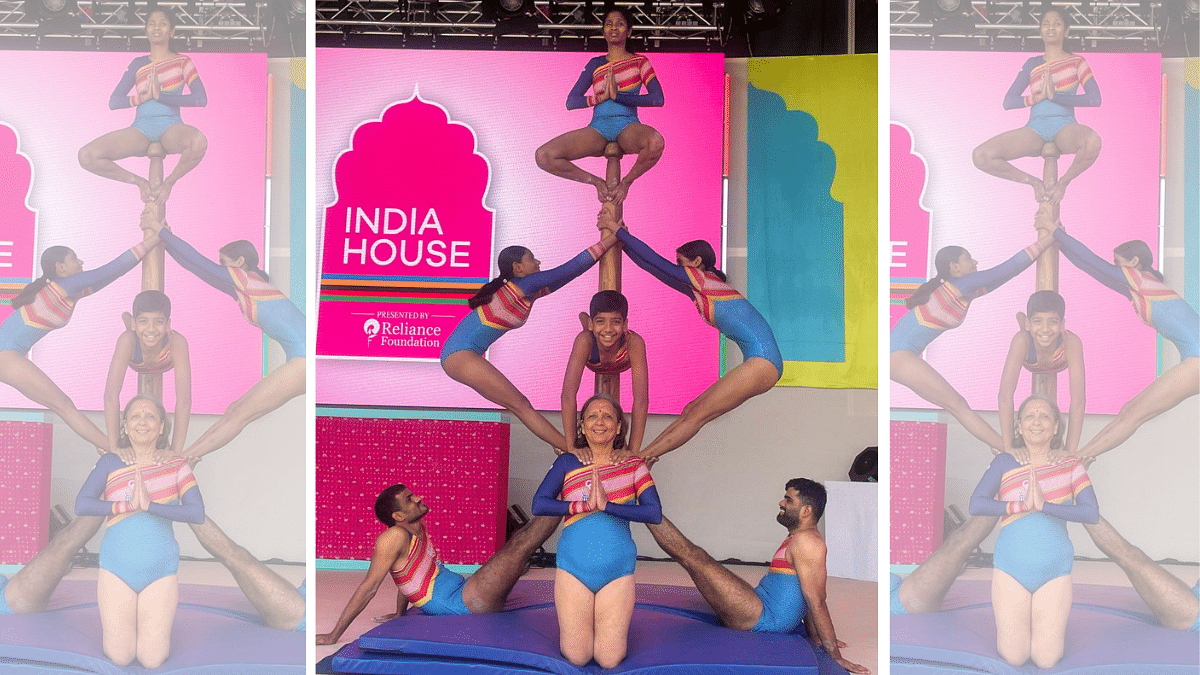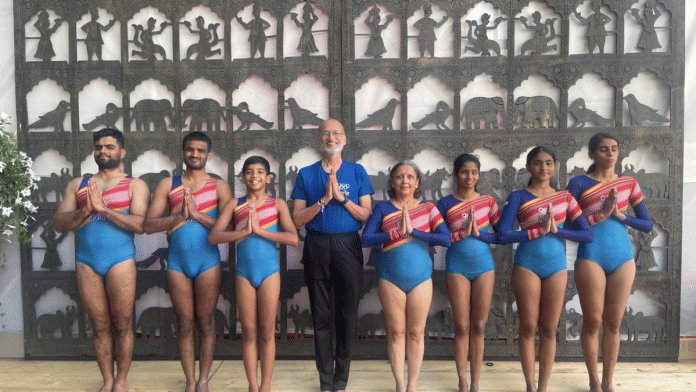Mumbai: As the Paris Olympics concluded Sunday, India had a lot to talk about. The exploits of the likes of Manu Bhaker, Sarabjot Singh, Swapnil Kusale, Neeraj Chopra, and Aman Sehrawat. The way the Indian men’s hockey team notched back-to-back medals for the first time since 1972. The unfortunate disqualification of Vinesh Phogat. And, there was mallakhamb, a traditional sport of Maharashtra, that came under the spotlight at the quadrennial extravaganza.
Every day from 29 July, a group of seven performers — four of them visually-impaired —enthralled viewers with their show of strength, balance and flexibility on a wooden pole and a rope, under the watchful eyes of their 71-year-old coach Uday Deshpande.
The ancient Indian sport was performed at the India House after a long gap at this event — it was showcased at the sidelines of the Berlin 1936 Olympics.
Deshpande, popularly known as ‘sir’ back home in Mumbai, is often credited for stirring global interest in mallakhamb over the years.
What left viewers further amazed was that four of the seven team members were visually impaired.
“Every morning and evening, we would perform at the India House. This is an extremely proud moment for all of us,” Deshpande says. “Training for the visually impaired is a bit challenging. Every action has to be told to them in as many words as possible for them to understand it. But I have been doing that since 1992.”
Deshpande, the head of Shree Samarth Vyayam Mandir at Shivaji Park in Dadar, Mumbai, is a Padma Shri recipient. He has been passing on mallakhamb skills to younger performers for the last six decades and also helped take this sport to international levels.
“We say our stomach is full after eating the fourth chapati (Indian bread). But the contribution of the first three chapatis is also important. Similarly, across the country, there are many teachers dedicating their lives for mallakhamb. So even if I got the Padma Shri, the contribution of others in the field can’t be overlooked,” Deshpande says.
Where it all began
On a balmy April morning at Shree Samarth vyayamshala, tucked away in a corner of the landmark Shivaji Park ground, a wooden pole 8 ft tall is fixed in the ground. Students line up to climb this pole. A student climbs on top of it and balances himself on the small round top at the head of the pole high in the air.
Another student sits on the top of the head, crosses the legs behind the pole and then drops his body weight to the ground upside down. More students follow and practice various ‘asanas’ (postures) on the pole. Deshpande stands a few feet away and observes them.
“In mallakhamb, all parts of the body get maximum exercise in the shortest time. Spine gets the best exercise because of this sport. It even helps grow immunity and resistance power. So the sport needs to grow and spread across borders,” he says.
Deshpande was merely 2-3-year-old when he joined Shree Samartha Vyayam Mandir.

Mallakhamb derives its name from two words: ‘malla’, the one who plays wrestling, and ‘khamb’, a pole.
If one goes by the folklore, Deshpande says, mallakhamb’s origins can be found in the Ramayana and Mahabharata period. Lord Hanuman is the pioneer of mallakhamb, he says.
But mallakhamb’s historical origins can be traced to the Peshwa period. “Balambhat Dada Deodhar in the darbar of Peshwa Bajirao II is known as the original guru of Mallakhamb,” Deshpande informs.
He was known to spread the sport across the country. Even today, after 250 odd years later, akhadas (gymnasiums) established by Balambhat Dada can be found from Maharashtra to Uttar Pradesh, he the veteran says.
But that was not the reason why he joined and learned the sport?
A young Deshpande used to see his grandfather perform yoga everyday in the morning. And that generated interest in physical activity. “And my grandfather suggested to my mother that I should be trained under Kale guruji,” he said.
Vyayam Mandir founder Prahlad Kale, the mentor to Deshpande, had worked together with Deshpande’s grandfather in the freedom struggle
He then started regularly going to the Vyayam Mandir, practised from 5:30 am to 6:30 am and then proceeded for his school at 7 am. And since then, the Vyayam Mandir is his second home. Such was his passion for the sport that even on his day of wedding, Deshpande did not skip his session.
In 1970, Deshpande along with four other boys performed at a silver jubilee function of Maheshwari Vidyalaya at Eden Gardens in Kolkata.
They performed mallakhamb on a bamboo pole. During their last act, the pole had broken. “But because of our presence of mind, we avoided the fall and people didn’t realise the stick had broken. So yes, bamboo mallakhamb was more risky,” Deshpande recalled.
During his time at Vyayam Mandir, Deshpande taught many students. Today, he has 100 boys and 100 girls getting trained at mallakhamb.
But one student he fondly remembers is Dattaram Dudham from 1971. Dattaram used to accompany his uncle Balu Dudham, who used to work as a gardener as well as attendant at the mandir. 10-year-old Dattaram used to observe Deshpande and the sport keenly.
One day, Deshpande asked Dattaram if he was interested in learning the sport. “Yes,” promptly the answer came.
Since then his journey began. Within a year, he came first in the district.
Practising from 5:30 am to 6:30 am, then going to school, and returning in the evening for the practice, that is how Dattaram honed the mallakhamb skills. And such tireless hard work, he went on to become the state-level champion for 8 years. He then went on to become national- level champion. Unfortunately, Dattaram passed away during the first wave of COVID-19.
Deshpande has been instrumental in spreading the sport across the nation. He became the secretary of Mallakhamb Federation of India in 1987; he travelled across states, gathered people, gave demonstrations, formed associations, and affiliated them to the federation.
Also Read: Changing demographics, redefined Hindutva — the Sena-Muslim dynamic, from Bal Thackeray to Uddhav
Women in mallakhamb
Earlier, Mallakhamb was primarily a men’s sport while women used to practice its equivalent — ‘rope mallakhamb’. Instead of a wooden pole, a rope is tied to the bar. Putting the rope in toes and carrying the weight of the body, one would climb up and perform ‘asanas’.
One of the reasons why women avoided mallakhamb earlier was that it is done bare-bodied to avoid friction and abrasions while performing for which castor oil is applied to the pole. “That is why only men would do it earlier. But in 2016 for the first time, we organised a tournament where women would also do pole mallakhamb,” Deshpande explains.
Over the years, the sport developed and advanced, and women in their gymnastic costumes or shorts can work on the pole. And girls normally concentrate on balancing movements rather than turning and twisting movements, Deshpande says.
“That way they can avoid the friction. Now the number of girls participating is going up and they perform various movements that even boys don’t do. Because naturally, girls are more flexible.”
Neeta Tatke, a retired professor and also one of the girls from Deshpande’s first batch, got trained at the age of 10.
She says that the difference between this sport and others is that it imparts a greater sense of achievement and hope. “There is a huge positive change now. Here at Samartha, we don’t just train people for competition. But anyone who wants to learn the sport, can come and learn.”
Tatke not only learned the sport and teaches the sport but also did her Ph.D in sport psychology with a specialisation in mallakhamb.
“Mallakhamb is a fitness activity, it is a tough sport. It gives a huge sense of achievement. It is my experience and research. It is about constantly handling and managing your emotions and being aware of the surroundings. I have seen results like problem solving, goal setting, positive approach,” she says.
Taking the sport international
Currently, there are various institutions in south, west, east, and north of India imparting training in mallakhamb. “After spreading the sport first in Mumbai, then state and later nationally, I decided to go international,” Deshpande says.
In 1997, Deshpande got an opportunity to go to Japan. It was a competition where in a 4X4 ft telephone booth, people have to accommodate as many as they can.
“We had practised for that competition and 15 people fit inside the booth. We won. So people asked us how you did it and we replied because of mallakhamb. And they asked us to demonstrate what it is. We had the pole with us and it was telecast live. That was our first international exposure,” Deshpande says.
And, that is how the journey began. Around 25 French people had founded an east-west cultural association in the early 1990s. They came to India and brought guests along where they stay with Indian families and learn about the culture. “We showed them mallakhamb and they were impressed,” Deshpande says.
He then got an opportunity to visit France along with a group for the exchange programme. In Paris, Marseille, and Nice, he demonstrated rope mallakhamb, took workshops and while returning, he went to an acquaintance’s house in London.
There he spoke with Indian associations to start mallakhamb in London. “There my student Usha Joshi met me and told me that she would follow up regarding this. And in December 1998, with 6 boys and 6 girls went to London and held workshops,” Deshpande recalls.
This was followed by a trip to San Jose, the US wherein he performed at a convention of the Maharashtrian community during the US Independence Day week in 1999.
“But the organisers told us that ‘since it is too late to be admitted, we cannot provide for your expenses but we could give you the chance to perform for 10 minutes’. I did the fund raising and even took loans to perform there. And the demonstration was effective,” he adds.
His international reach grew and he conducted workshops, showed demonstrations across various countries. Today, people from countries like Germany and France have learnt both forms of mallakhamb and introduced the sport in their institutions.
In February 2019, the first world championship of mallakhamb was conducted at Shivaji Park where participants came from 15 countries. A Japanese girl came first in the championship.
“I had taught her,” Deshpande says with pride.
(Edited by Tony Rai)
Also Read: Inadequate infra, global slowdown, rivalry & politics — Surat Diamond Bourse has rocky start






